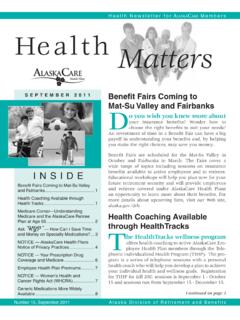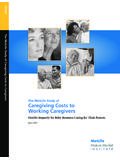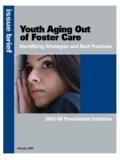Transcription of The Solution To Rising Health Premiums - Trust …
1 The Solution To Rising Health PremiumsCONSUMER DRIVEN Health CARETRUST ADMINISTRATORS, 510-451-2810 Health ReimbursementArrangementsHealth Savings AccountsFlexible Spending Accounts 2005 All Rights ReservedAn Overview of:1970 Broadway, Suite 1140 Oakland, CA 94612An Introduction to Consumer Driven Health CareFlexible Spending Accounts (FSAs): The idea of consumer driven Health care is not new. It started with the Tax Reform Act of 1978 and the enactment of cafeteria plans under Internal Revenue Code section 125 effective January 1, 1979. Because many small employers were unable to match their larger rivals in offering employees a smorgasbord of benefits to choose from, including a cash-out option, Flexible Spending Accounts ( FSAs ) were created and officially sanctioned in March, 1984 by the addition to allowing employees to set aside up to $5,000 per calendar year per household for adult or child care expenses, Health FSAs allow employees to deduct pre-tax salary to pay for co-insurance, deductibles, mileage and lodging related to medical care and over-the-counter drugs for themselves, their spouse and dependents (including domestic partners).
2 The drawback to FSAs was that unclaimed amounts were forfeited ( use-it or lose-it rule). But, on 5/18/05 the IRS issued Notice 2005-42 allowing participants to rollover funds and incur expenses for up to 2-1/2 months in the new plan year exhausting prior Reimbursement Arrangements (HRAs): HRAs are also not a new phenomenon since they are a form of self-funding under Code section 105(h). HRAs are funded solely by employers. These plans have been around for over 50 years and in practice, operate like employer-funded Health FSAs. According to Department of Labor attorney Susan Abelson, HRAs present the easiest way for employers to control Rising Premiums since they can pick and choose the benefits they want to fund. Health Savings Accounts (HSAs): HSAs represent the newest type of Health plan within the consumer driven movement and are akin to medical IRAs. They were created by the Medicare Prescription Drug, Improvement, and Modernization Act of 2003, effective 1/1 approach is best?
3 Individuals and employers with young employees should consider HSAs since the Premiums are low and contributions can be made pre-tax through an FSA under federal tax law and in most states. Employers may also contribute to the employees accounts either as a flat amount or a percentage based on the employees contributions - like a 401(k). The main concern with HSAs involve the cost for co-payments and deductibles along with the tax implications for improper HSA usage. HRAs fit the entire size range of employers, from small to very large, because the employer s reimbursement risk is determined in advance and therefore predictable. Unused funds may be carried forward to subsequent plan years, but is not required. FSAs provide tax savings for both employees and employers and are a perfect compliment to both HSAs and HRAs (see page 7 for details about coordinating all the consumer driven Health care plans).About Trust Administrators, firm was founded in 1984 by Royce A.
4 Charney, , a former official with the Department of Labor s Pension Welfare Benefit Administration in San Francisco. While at the DOL, starting in 1979, Mr. Charney worked with the IRS, FBI, Comptroller of the Currency and other agencies regarding the administration and enforcement of the Employee Retirement Income Security Act of 1974 ( ERISA ).Mr. Charney provided technical advice to other attorneys, union officials, employers, employees and brokers regarding Health and retirement benefits. Most issues centered around fiduciary duties and prohibited transactions under ERISA, but also involved investments and overall benefit plan compliance. During this time, Mr. Charney provided local litigation support for the Labor Department s solicitor and worked on some of the most prominent and complicated cases on the West Coast. Over the last 26 years, Mr. Charney has authored numerous articles about employee benefits. He also conducts continuing education seminars for certified public accountants and insurance agents throughout California.
5 Today, the firm has grown into one of the premier administrators for cafeteria, commuter, self-funded dental and vision plans, Health reimbursement and Health savings accounts. For additional information, contact Trust Administrators, Inc. 1970 Broadway, Suite 1140 Oakland, CA 94612 510-451-2810 Fax: 510-451-8611 2005 Trust Administrators, Inc. This Consumer Driven Health care Overview and HRA, FSA and HSA Comparison are protected by copyright laws and treaties. You may make a single copy for personal use and others, but not for commercial purposes. If you give a copy to anyone, it must be in its original, unmodified form and must include all attributions of authorship, copyright notices and republication notices. Except as described above, it is unlawful to copy, republish, redistribute and/or alter this document without the prior written consent of Trust Administrators, by statute. Plan must be a High Deductible Health Plan (HDHP) with at least a $1,000 deductible for individual (maximum of $5,000 total out-of-pocket other than Premiums ) and a deductible of $2,000 for family coverage ($10,000 total out-of-pocket cap).
6 IRC 223(c)(2)(A), IRS Notice 2004-2, Q&A 7. Out of network plans may exceed the deductibles noted above and still qualify as an HDHP. IRC 223(c)(2)(D).If spouse is covering individual under a non-HDHP, individual may not participate in HSA. However, coverage for accidents, disability, dental, vision, or long-term care is allowed - referred to as permitted coverage. IRC 223(c)(1) and (1)(B), Rev. Rul. 2004-38. Same as HRA for account holder, spouse or qualifying dependents to the extent not covered or reimbursed by insurance or otherwise. Using HSA for non-qualified expenses means individual pays income tax on amount plus a 10% penalty tax. Long-term care insurance may be purchased with HSA, IRC 223(d)(2)(A) and over the counter drugs (IRB: 2004-2, 1/12/04). Same as HRA and funds may not be used to purchase other Health insurance except for COBRA premium, Health insurance while unemployed or Medicare Parts A and B or Medicare HMO policies, not Medigap policies.
7 Notice 2004-2, Q&A or any business entity without HRA or FSA : Some states do not recognize an income tax deduction for HSA premium, the amount contributed to savings account or HSA HMO, HSA, PPO, POS or indemnity plan may have an HRA feature per Code 105(h). Some carriers have specific HRA cover expenses for: employees, retirees, COBRA qualified beneficiaries, spouses and dependents (and domestic partners - note the tax consequences if not dependent for income tax purposes), Notice 2002-45 (6/26/02), PLR , dental, vision, chiropractic, mileage, over-the-counter drugs and supplies, lodging; Code 213(d), Rev. Ruls. 2003-58, 2003-102. May reimburse for individually owned Health , dental or disability insurance; not long term care , Code 7702B(c). See also Rev. Rul. 61-146. Preventive care includes: Health evaluations, routine exams, prenatal/well-child care , child/adult immunizations, tobacco cessation, obesity weight loss programs and screening : Definition of preventive care items set by Corp.
8 Owners and their rank and file employees. Individuals, Owners of LLCs, LLPs, 2% S Corp. owners, sole-proprietors, partnerships, not eligible for pre-tax premium or Health FSA; Code 105(g), 162(l), but may deduct premium on Schedule C tax return. See also Notice 2002-45, Part share in the overall HRA Requirements andEligibility RulesQualified ExpensesParticipation - Individual or BusinessHealth Reimbursement Arrangements (HRA) Health SavingsAccounts (HSA)Part One: Plan Design & Tax IssuesSame as HRA except Premiums for insurance policies not sponsored by Employer with FSA Plan is prohibited, IRS Prop. Reg. , Q&A 7(b)(4), 3/7/89. No retiree benefits. FSA codified in Code 106(c) under 301(c)(2) of HIPAA 1996. Same as HRA for all Code 213(d) expenses for Health FSA enrollees and their for insurance policies not sponsored by Employer with FSA Plan is prohibited, IRS Prop. Reg. , Q&A 7(b)(4), 3/7/89. Retirees ineligible because no salary care includes: Health evaluations, routine exams, prenatal/well-child care , child/adult immunizations, tobacco cessation, obesity weight loss programs and screening business entities eligible for Dependent care , Code 129(e)(3).
9 For all other business entities, HRA rules Spending Accounts (FSA)-3-None by But, upon IRS audit, account holder must provide substantiation, Notice 2004-2, Q&A 37. If employer funds HSA, claims may be required for reimbursement and subject the HSA to ERISA, outside the safe harbor provision - see below under ERISA Covered. Individual and/or : If Employer funded, must contribute same amount for each employee whether or not funds used. Employer subject to 35% excise tax on the aggregate HSA amount for failing to follow rule. Code 4980G(a). A 6% excise tax is levied on individual for excess contributions (calculated on a monthly basis) for an eligible individual are the lesser of 100% of the in-network annual deductible of the HDHP up to $2,650 for self-only coverage or $5,250 for family coverage in 2005. IRC 223(b)(2). Limits are indexed. Account holders age 55 and up may make additional contributions of $500 in 2004, increasing by $100 each year until it reaches $1,000 in 2009.
10 If Employer contributes to HSA, contributions must be equal for all employees. IRC 4980G and E(d)(4). Employees keep Employer contributions if they terminate employment. Not subject to FICA, Notice 2004-2, Q&A 19. The annual contribution limits apply whether an employee, employer or a self-employed person makes the : There is no requirement that the individual have earnings. The limit is zero for a Medicare eligible individual ( individual who has attained age 65). IRC 223(b)(7).None by Each expense submitted for reimbursement must be substantiated, Notice 2004-45, Sec. II, 2002-28 IRB 93. When using debit or credit cards, substantiation required if system cannot identify products purchased, Rev. Rul. 2003-43, 2003-21 IRB Only, Code 105(h)(6)None by statute. Employer may impose reimbursement or benefit limits to control risk. Note: HRAs will save Employers more money than Employer funded HSAs because HRA funds are used only as needed to pay claims when incurred while HSA contributions are made to each employee s account whether or not the money is spent for qualified expenses.





